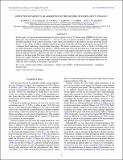DETECTION OF MOLECULAR ABSORPTION IN THE DAYSIDE OF EXOPLANET 51 PEGASI b?
Author(s)
Brogi, M.; Snellen, I. A. G.; de Kok, R. J.; Albrecht, Simon H.; Birkby, J. L.; de Mooij, E. J. W.; ... Show more Show less
DownloadBrogi-2013-DETECTION OF MOLECUL.pdf (1000.Kb)
PUBLISHER_POLICY
Publisher Policy
Article is made available in accordance with the publisher's policy and may be subject to US copyright law. Please refer to the publisher's site for terms of use.
Terms of use
Metadata
Show full item recordAbstract
In this paper, we present ground-based high-resolution spectroscopy of 51 Pegasi using CRIRES at the Very Large Telescope. The system was observed for 3 × 5 hr at 2.3 μm at a spectral resolution of R = 100,000, targeting potential signatures from carbon monoxide, water vapor, and methane in the planet's dayside spectrum. In the first 2 × 5 hr of data, we find a combined signal from carbon monoxide and water in absorption at a formal 5.9σ confidence level, indicating a non-inverted atmosphere. We derive a planet mass of M [subscript P] = (0.46 ± 0.02)M [subscript Jup] and an orbital inclination i between 79fdg6 and 82fdg2, with the upper limit set by the non-detection of the planet transit in previous photometric monitoring. However, there is no trace of the signal in the final five hours of data. A statistical analysis indicates that the signal from the first two nights is robust, but we find no compelling explanation for its absence in the final night. The latter suffers from stronger noise residuals and greater instrumental instability than the first two nights, but these cannot fully account for the missing signal. It is possible that the integrated dayside emission from 51 Peg b is instead strongly affected by weather. However, more data are required before we can claim any time variability in the planet's atmosphere.
Date issued
2013-04Department
MIT Kavli Institute for Astrophysics and Space ResearchJournal
Astrophysical Journal
Publisher
Institute of Physics/American Astronomical Society
Citation
Brogi, M., I. A. G. Snellen, R. J. de Kok, S. Albrecht, J. L. Birkby, and E. J. W. de Mooij. “DETECTION OF MOLECULAR ABSORPTION IN THE DAYSIDE OF EXOPLANET 51 PEGASI B?” The Astrophysical Journal 767, no. 1 (March 21, 2013): 27. © 2013 American Astronomical Society.
Version: Final published version
ISSN
0004-637X
1538-4357